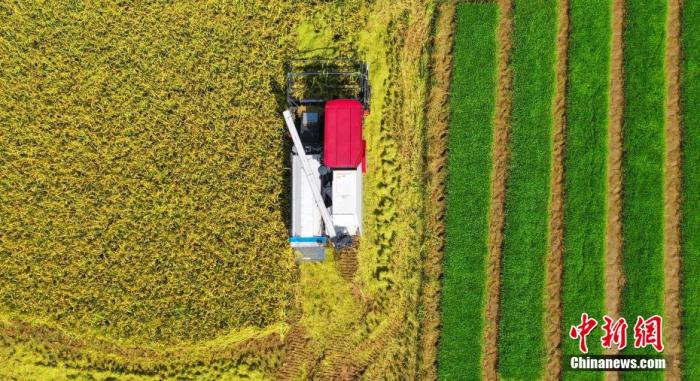Chinanews.com, August 25. The National Bureau of Statistics website today published an announcement on the data of early rice production in 2021.
Li Suoqiang, director of the Rural Department of the National Bureau of Statistics, pointed out when interpreting the production of early rice that in 2021, the sown area of early rice nationwide will steadily decrease slightly, yields have resumed growth, and the output of early rice will increase slightly compared with the previous year.
According to the survey results of the actual harvest of early rice in 10 provinces (regions), the total output of early rice in the country is 28.02 million tons (56 billion jin), an increase of 723,000 tons (1.45 billion jin) over 2020, an increase of 2.7%.
Data map: The harvester is rushing to harvest early rice.
Photo by Deng Heping
The sown area of early rice steadily declined slightly
According to Li Suoqiang, the sown area of early rice nationwide in 2021 was 47,34 thousand hectares (71.01 million acres), a decrease of 16.6 thousand hectares (249,000 acres) or 0.4% from the previous year.
Among them, the sown area in Guangxi and Jiangxi increased by 23,000 hectares (35,000 mu) and 13,000 hectares (19,000 mu), an increase of 0.3% and 0.1%; affected by drought and the adjustment of planting structure, the sown area decreased by 10.6 in Guangdong and Hunan. 1,000 hectares (159,000 acres) and 6.1 1,000 hectares (92,000 acres), down 1.2% and 0.5%.
The sown area of early rice has declined mainly due to the following two factors.
First, the weather and drought affect the timely transplanting of early rice.
Some areas in southern China have poor weather conditions for spring planting, with less rainfall than normal. Guangdong, central and southern Guangxi and other places have insufficient water storage, and some plots have poor irrigation conditions, which affects the timely transplantation of early rice, and farmers switch to corn, sweet potato and other crops. .
The second is to adjust the planting structure to reduce early rice planting.
The planting structure of the contaminated farmland in Hunan's strictly controlled area was adjusted, and rice planting was withdrawn, resulting in a decline in the planting area.
However, various localities have taken multiple measures to stabilize early rice production, layered layers of responsibility for grain production, increased policy support, carried out reclamation and replanting of abandoned land, encouraged large grain growers, professional cooperatives, and agricultural enterprises to plant early rice, and implemented various support for agriculture and farmers. , Grain subsidies, minimum grain purchase prices and other policies, the sown area of early rice has remained basically stable.
Early rice yields have increased
Li Suoqiang pointed out that the national early rice yield in 2021 is 5918 kg/ha (395 kg/mu), an increase of 173.0 kg/ha (11.5 kg/mu) over the previous year, an increase of 3.0%.
Among them, Anhui, Hubei, and Jiangxi were affected by severe floods last year. The yield per unit was significantly reduced. This year, the yield has been restored, increasing by 449.3 kg/ha (30.0 kg/mu), 359.3 kg/ha (24.0 kg/mu) and 210.3 respectively. Kg/ha (14.0 kg/mu), an increase of 8.4%, 6.4% and 4.0%.
Since the early rice was planted, the weather conditions in most of the main producing areas were relatively good, and the occurrence of phased rainy, ignorant and flood disasters was relatively light, which is generally conducive to the growth and development of early rice and the formation of yield.
From sowing and raising seedlings to the re-greening period of transplanting, the temperature in the early rice producing areas is relatively high, the sunlight is sufficient, the rainfall is timely, and the seedlings are neat and strong.
From tillering and jointing to booting and heading stage, there have been many regional strong precipitation processes in Jiangnan and northern South China, but the weather has improved significantly in the later period, and the light and temperature resources are abundant, which is conducive to heading and fruiting and pest control.
During the grain-filling harvest period, the early rice producing areas are dominated by sunny, hot and less rainy weather, and the number of high-temperature days is more than that of the same period in normal years, which is conducive to early rice filling and maturity.
At the same time, although some areas along the coast were affected by the typhoon and early rice lodging, the overall impact was limited.
"Under the background of the continuous evolution of the global epidemic and the complex and severe external environment, the bumper summer grain harvest and the increase in early rice production have laid the foundation for stable grain production throughout the year and provided strong support for the "14th Five-Year Plan" to make a good start and start. "Li Suoqiang said.

